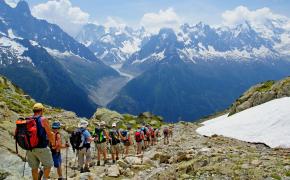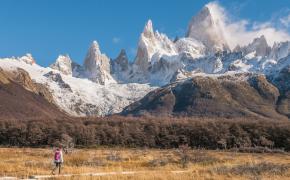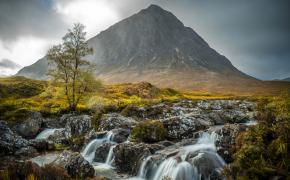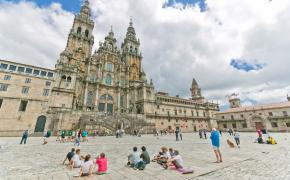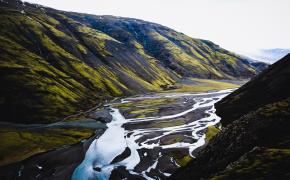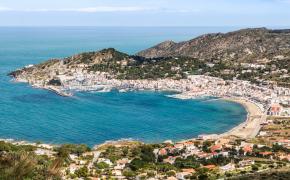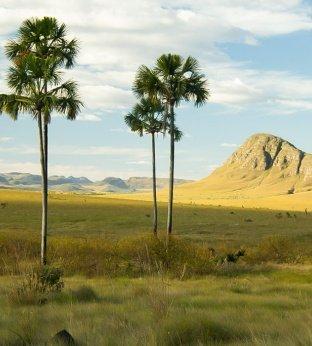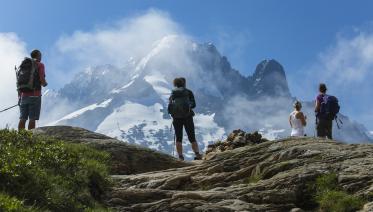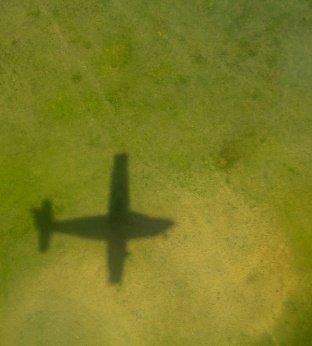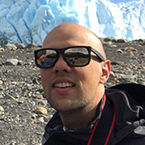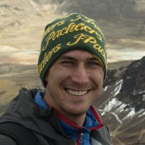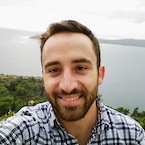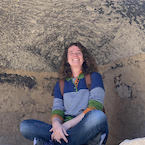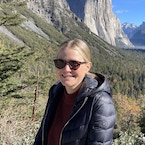The Camino de Santiago is less of a singular “Way” (as the name would imply) as it is a collection of incredibly various paths. The vast network of the Camino de Santiago stretches across the Iberian Peninsula and further across western and central Europe, with some “official” routes reaching Germany and Austria. There are even stories of pilgrims starting as far away as Israel and trekking for months to the tip of Spain.
Traditionally, there was no single pilgrimage route. Those who set out to Santiago de Compostela would start and end their pilgrimage at their own front door. According to the Pilgrim's Office of Santiago Cathedral, there is still no set starting point to the Camino; a pilgrimage can start anywhere in the world, so long as it is completed on foot, horseback, or bicycle. Our itinerary follows part of the Camino Francés, the most well-known and well-traveled “official” pilgrimage route.
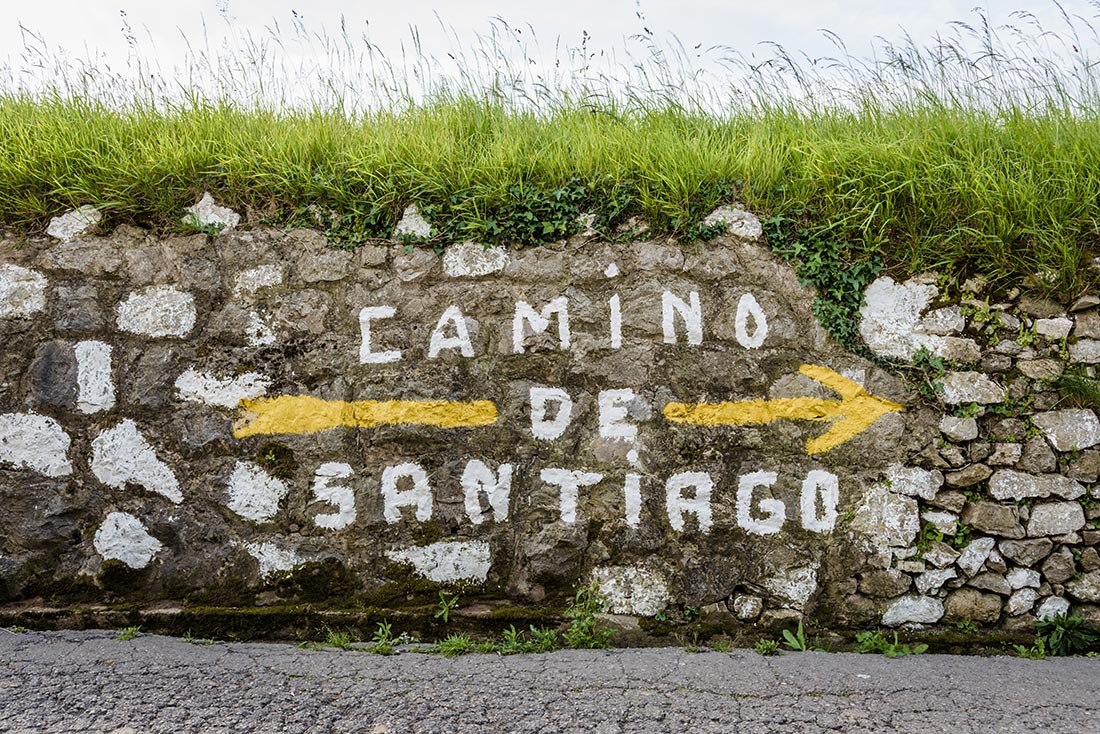
Camino Francés Overview
If you’ve done any research at all on the Camino de Santiago, you’ve probably seen something about the Camino Francés. It’s unavoidable. This is the best-known and most-traveled route, and for many reasons. It is the also the oldest known route, having been described in the Codex Calixtinus, a Camino de Santiago travel guide from the 12th century.
The Camino Francés, literally “the French Way” begins in far southwestern France in Saint-Jean-Pied-de-Port, a picturesque city at the foothills of the Pyrenees mountains. After crossing the border, it meanders through the Spanish regions of Navarre, La Rioja, Castilla y León, and Galicia, each of them with its own unique history and culture.
Pilgrims generally complete this route in about four weeks, but bicyclists (and really speedy hikers) can finish in half that time. But almost no one can take a full month off or hike 40 km per day, which is why we’ve cut our itinerary down to a manageable two weeks of hiking that still offer an excellent Camino experience.
For the more time pressed pilgrim, you can start in Leon, which is a little more than half way from the French border. This itinerary fits nicely in a two week holiday and you can fly in easily to Madrid. There are many places to visit in Madrid, so it's a great city to spend a few days before or after your tour.
Camino Francés History
The history of the Camino Francés begins in the 11th century in Spain in the kingdom of Pamplona with a king called Sancho the Great. Sancho Garcés III ruled at a very interesting time in Spain’s history. For hundreds of years, much of the Iberian Peninsula had been controlled by the Umayyad family, a Muslim dynastic clan based in Mecca. Even though Umayyad power was in decline in Sancho’s time, there was still significant conflict between the Christian and Muslim powers, and Sancho, himself a Christian, wanted to solidify his power.
Take a look at the map of the Camino Francés below, and you can see that it traces a route through northeastern Spain—through the very heart of Sancho’s kingdom. In fact, the city of Pamplona, the seat of Sancho’s power, is still a major stop on the route today. Sancho realized that he could use the Camino Francés to increase control of his territory, and that by attracting pilgrims (and the attention of the Catholic Church) he could gain territorial control while benefiting economically.
He took significant measures to improve the Camino in his territory, expanding hospitality services for pilgrims and freeing them from some tax obligations. He also moved the route south to flatter, easier terrain, which benefited pilgrims as well as merchants and, of course, Sancho’s armies. His actions also led to certain Christian religious orders entering Spain, which worked to further improve and cement the Camino Francés.
Sancho the Great’s work was inspiring, and his grandsons Alfonso VI, King of Castilla y León, and Sancho Ramírez, King of Aragon and later King of Pamplona, would continue his work, expanding the Christian territories using the Camino Francés as a wedge. Together, these three took enormous steps to develop and promote the Francés route, and the continuing popularity of the route to this day is a testament to their successes.
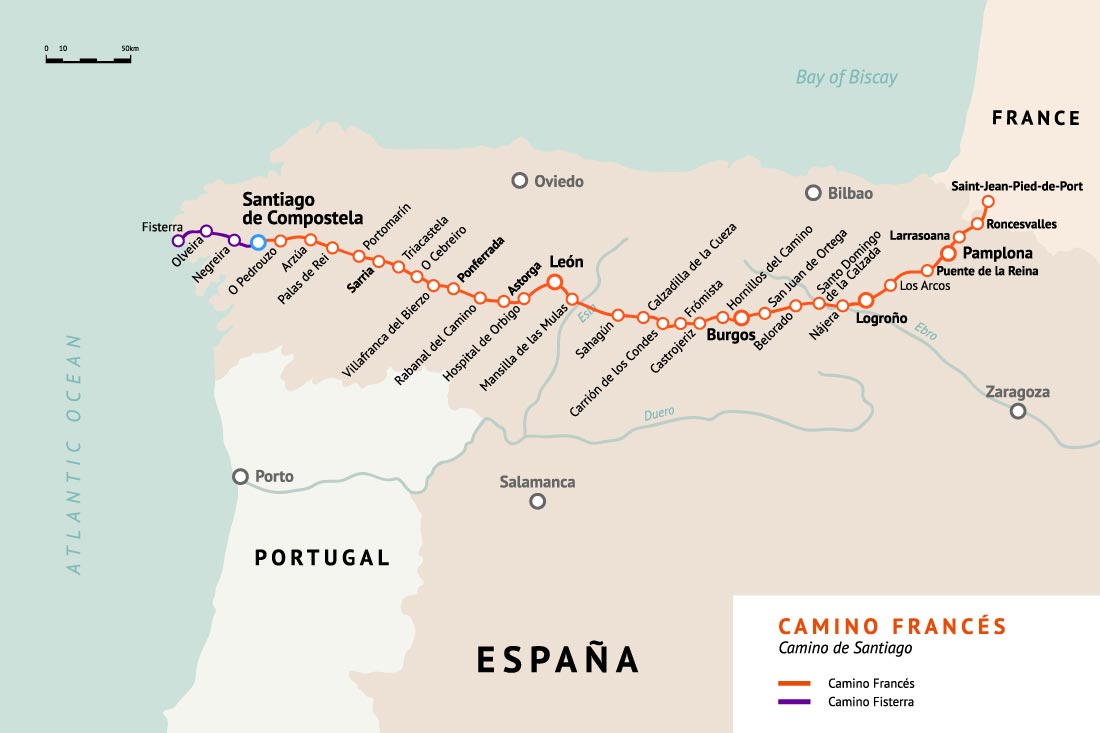
The Camino Francés Route
Camino Francés, the Pygmy Elephant Way
Today, the Camino Francés is a celebration of culture and a testament to its long history. Pilgrims are treated to magical scenes, historical sites, and long traditions unique to this path. Though the Camino Francés from beginning to end is more than deserving of a well-written post, for the sake of time we’ll just focus on most—but not all—of the cities on our itinerary.
Our route begins in the region of Castilla y León, which has existed in some capacity for more than 1,000 years. It is the largest region in Spain and makes up the largest part of the Camino Francés route. Over 60% of Spanish heritage sites are found here, along with eight UNESCO World Heritage sites, more than any other region in the world.
The second half of our itinerary meanders through Galicia, an ancient region which has been inhabited by humanity for at least 30,000 years, and likely much, much longer. Megalithic structures reminiscent of Stonehenge can still be found dotting the countryside, but mostly in coastal areas. Over the centuries this region has been controlled in turn by Celts, the Roman Empire, Germanic tribes, the Umayyad Caliphate, and various kings, both Spanish and Galician.
León
León is the capital of the province of León and where we begin our itinerary. The city began as a Roman military encampment more than 2,000 years ago in 29 BC, but only achieved true historical significance in 910 AD, when it became the capital of the Kingdom of León, one of the pivotal kingdoms of medieval Spain. The city is a cultural treasure, home to the Basilica of San Isidoro, the Monastery of San Marcos, and Antoni Gaudí’s Casa Botines. The Cathedral of León, known for its spectacular stained glass windows, is one of our top eight destinations on the itinerary.
The Semana Santa, the Holy Week observed directly before Easter, is celebrated in León with a number of parades related to the religious holiday. However, the Leónese also observe the local “Burial of Genarín,” which commemorates the death of the alcoholic beggar Genarín, killed by León’s first garbage truck in 1929. Participants drink themselves into a stupor in his honor.
Though Spain is known for its pork products, the city of León is famous for cecina, or cured, smoked beef. It might not be a bad idea to take some along for your hike.
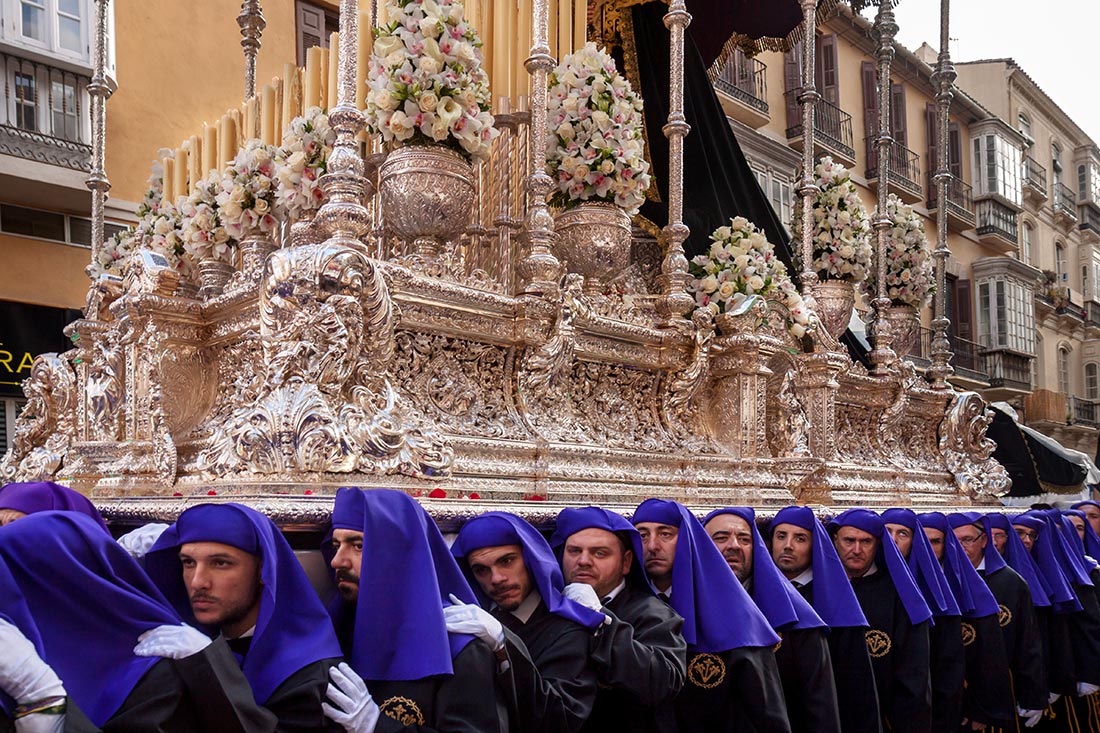
A traditional Semana Santa procession
Astorga
The region around Astorga is truly ancient, with a plethora of ancient artifacts pointing to a history over 200,000 years old. Surprisingly enough, it is the birthplace of European chocolate culture, beginning production of the stuff in 1528 when Hernán Cortés returned with cacao beans from Mexico. At one point Astorga was home to 64 chocolate factories, and still produces some of the finest chocolate in Europe (though Switzerland and Belgium might disagree).
Pro-tip: After visiting Gaudí’s Palacio Episcopal, you could stop by Confiteria Velasco or Hojaldres Alonso for a taste test.
Rabanal del Camino
The tiny town of Rabanal del Camino, total population of 74, has a surprisingly big history. Because of its location directly before Mount Irago, Rabanal was host to multiple lodges and churches for pilgrims, and was possibly a satellite location for the Order of Santiago, the Templar-like knights who offered pilgrims protection. The renaissance of the Camino de Santiago has been a boon for the tiny community, affording it enough resources to build or rebuild hospitality service for travelers.
Pro-tip: Stop by the local church to hear the Gregorian chanting worship service, held five times a day.
Las Herrerías, Triacastela, and O Cebreiro
Las Herrerías and Triacastela are both mentioned in the Codex Calixtinus, and straddle the border between Castilla y León and Galicia, with the curious O Cebreiro directly between them.
The name Las Herrerías translates to “the blacksmith shops” or “the smithies”, inspired no doubt by the iron that was mined in local hills and worked by the local citizens. The area is known for its stone bridges dating back to Roman rule, which still carry pilgrims across streams and rivers today. Triacastela was named for the three castles which once stood here, and was at one point invaded by the Normans, who were held off at the pass of O Cebreiro above the city. According to the writer of the Codex, limestone was taken from the nearby quarry to the kilns in Castañeda, where it was made into bricks for the Cathedral of Santiago de Compostela.
O Cebreiro is a notable stop. The high elevation village is often shrouded in mist, the local church tolling its bell to act as a guide for pilgrims. One of two holy grails is housed here, this one dating back to the 14th century, when the bread and wine in a mass directed by the village priest allegedly turned to flesh and blood. The stone pallozas in the village are a reminder of a very long history.
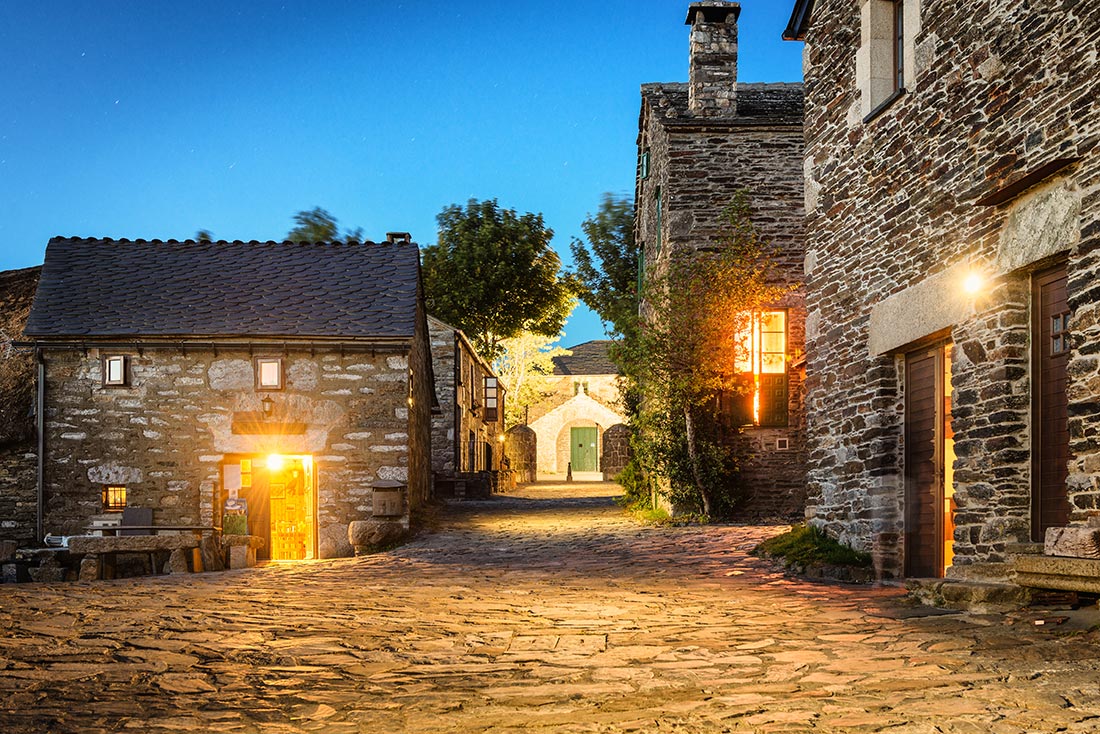
O Cebreiro at night
Sarria
Sarria is where many pilgrims start their pilgrimage, as it just meets the 100 km distance required to earn a Compostela or Certificado. Because of its popularity, it offers a wide range of leisure activities and cuisine for interested pilgrims. A Galician favorite that can be easily found in Sarria is octopus, here known as pulpo, freshly grilled or boiled and sprinkled with salt.
Sarria is also well-known for its festivities and holidays. Those passing through Sarria between February and March can check out the lively Carnival festival, and those who don’t mind a (very big) crowd would enjoy the Easter processions through the city center. If you’re willing to brave the hot summer season, Corpus Christi in June is celebrated with the weaving of intricate flower carpets throughout the city, and the last Saturday in August is the Noite Meiga, or Witches Night, when Galicians drink Queimada and remember their ancient, druidic past.
Portomarin
The city of Portomarin was moved from its old location by the river Miño in 1962 when the area was flooded to make a reservoir, and the Church of San Juan of Portomarin was moved brick-by-brick and reassembled in its new location. The city is well-known for its very good aguardente, or Spanish schnapps. Have a tipple while you’re there!
Arzúa
Curiously enough, the population of Arzúa is largely of Basque heritage, a long way from their traditional homeland near the Spanish-French border. Arzúa has a long history of keeping cattle, which has led to a famous culture of cheese production. The first Sunday of March is home to the cheese festival, a celebration of Arzúa’s favorite food. And of course, a long hike like the Camino de Santiago is the perfect reason to stock up on some delicious, protein-filled queso.
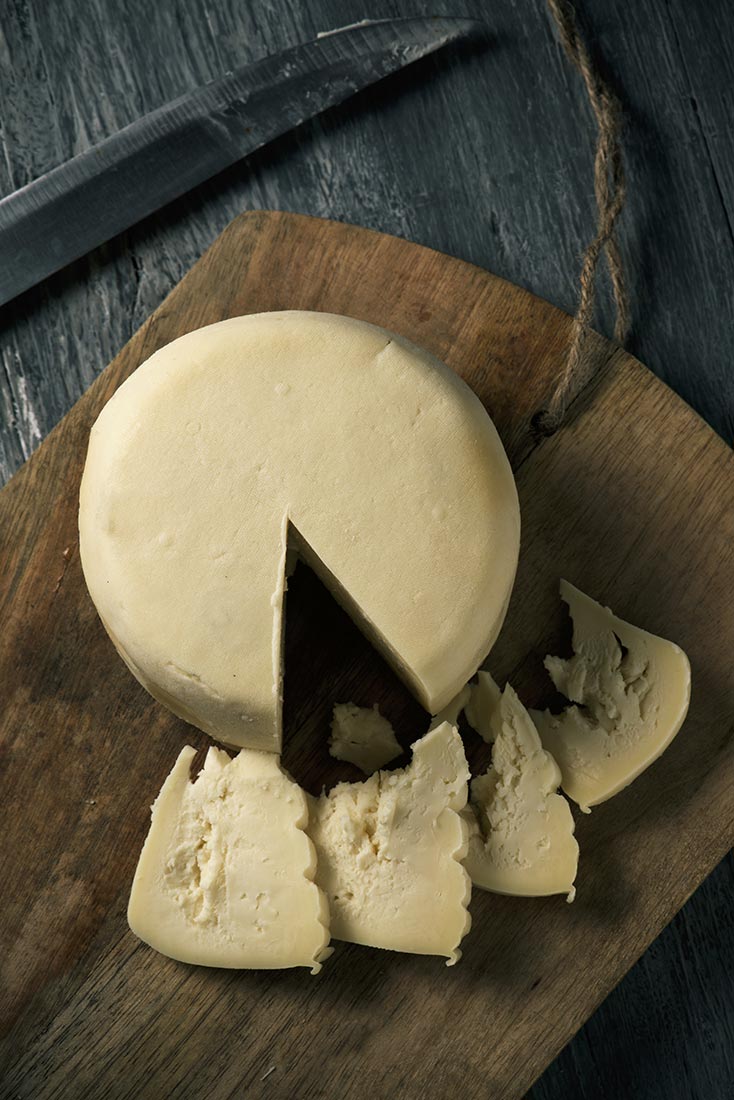
Arzúa-Uolla cheese, a typical variety from Arzúa
Santiago de Compostela
Santiago de Compostela is the ultimate goal and the crown jewel of the Camino. As we covered in our post about the Camino de Santiago’s history, Santiago de Compostela grew up around the remains of St. James the Greater, which are found in the Cathedral here. This area has been the site of a Roman cemetery, inhabited by Germanic tribes, invaded by Arab forces, raided by Vikings, captured by French armies, and passed through the hands of numerous bishops and kings. Besides its importance for the Christian world, Santiago de Compostela is incredibly to Spanish and European history in general.
Your Camino
You don’t have to be a Catholic to walk the Camino. In fact, you don’t need to be Christian or religious at all. Some take the pilgrimage just to walk across beautiful, ancient landscapes that humans have traversed for thousands of years. Some do it to take in the wonderful historical experiences along the way. And others just need a vacation that’s a little out of the ordinary.
Let us help you make your Camino experience a great one. We’d love to tell you more about this trip of a lifetime and share some of our tips to making it even better. Just write us an email or call us at 1-414-377-3555 for a free consultation on this Camino adventure

















